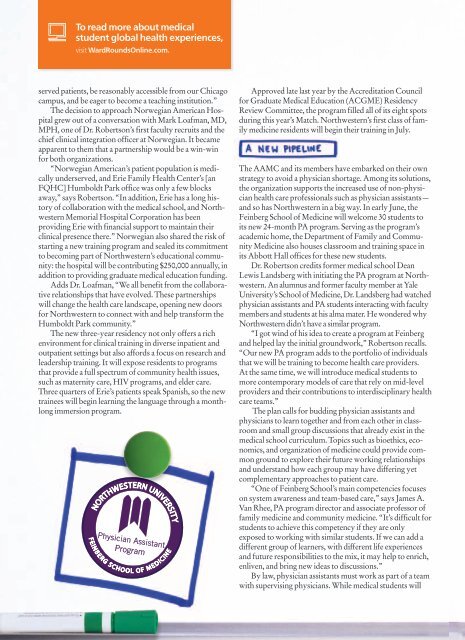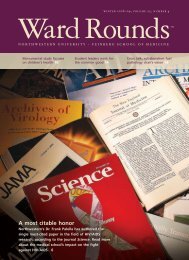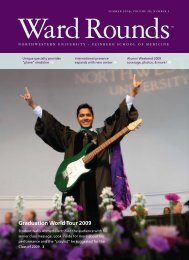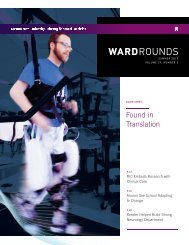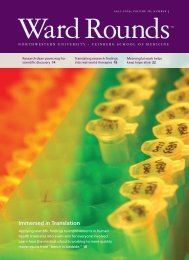Download PDF - Ward Rounds - Northwestern University
Download PDF - Ward Rounds - Northwestern University
Download PDF - Ward Rounds - Northwestern University
You also want an ePaper? Increase the reach of your titles
YUMPU automatically turns print PDFs into web optimized ePapers that Google loves.
To read more about medical<br />
student global health experiences,<br />
visit <strong>Ward</strong><strong>Rounds</strong>Online.com.<br />
served patients, be reasonably accessible from our Chicago<br />
campus, and be eager to become a teaching institution.”<br />
The decision to approach Norwegian American Hospital<br />
grew out of a conversation with Mark Loafman, MD,<br />
MPH, one of Dr. Robertson’s first faculty recruits and the<br />
chief clinical integration officer at Norwegian. It became<br />
apparent to them that a partnership would be a win-win<br />
for both organizations.<br />
“Norwegian American’s patient population is medically<br />
underserved, and Erie Family Health Center’s [an<br />
FQHC] Humboldt Park office was only a few blocks<br />
away,” says Robertson. “In addition, Erie has a long history<br />
of collaboration with the medical school, and <strong>Northwestern</strong><br />
Memorial Hospital Corporation has been<br />
providing Erie with financial support to maintain their<br />
clinical presence there.” Norwegian also shared the risk of<br />
starting a new training program and sealed its commitment<br />
to becoming part of <strong>Northwestern</strong>’s educational community:<br />
the hospital will be contributing $250,000 annually, in<br />
addition to providing graduate medical education funding.<br />
Adds Dr. Loafman, “We all benefit from the collaborative<br />
relationships that have evolved. These partnerships<br />
will change the health care landscape, opening new doors<br />
for <strong>Northwestern</strong> to connect with and help transform the<br />
Humboldt Park community.”<br />
The new three-year residency not only offers a rich<br />
environment for clinical training in diverse inpatient and<br />
outpatient settings but also affords a focus on research and<br />
leadership training. It will expose residents to programs<br />
that provide a full spectrum of community health issues,<br />
such as maternity care, HIV programs, and elder care.<br />
Three quarters of Erie’s patients speak Spanish, so the new<br />
trainees will begin learning the language through a monthlong<br />
immersion program.<br />
Approved late last year by the Accreditation Council<br />
for Graduate Medical Education (ACGME) Residency<br />
Review Committee, the program filled all of its eight spots<br />
during this year’s Match. <strong>Northwestern</strong>’s first class of family<br />
medicine residents will begin their training in July.<br />
The AAMC and its members have embarked on their own<br />
strategy to avoid a physician shortage. Among its solutions,<br />
the organization supports the increased use of non-physician<br />
health care professionals such as physician assistants—<br />
and so has <strong>Northwestern</strong> in a big way. In early June, the<br />
Feinberg School of Medicine will welcome 30 students to<br />
its new 24-month PA program. Serving as the program’s<br />
academic home, the Department of Family and Community<br />
Medicine also houses classroom and training space in<br />
its Abbott Hall offices for these new students.<br />
Dr. Robertson credits former medical school Dean<br />
Lewis Landsberg with initiating the PA program at <strong>Northwestern</strong>.<br />
An alumnus and former faculty member at Yale<br />
<strong>University</strong>’s School of Medicine, Dr. Landsberg had watched<br />
physician assistants and PA students interacting with faculty<br />
members and students at his alma mater. He wondered why<br />
<strong>Northwestern</strong> didn’t have a similar program.<br />
“I got wind of his idea to create a program at Feinberg<br />
and helped lay the initial groundwork,” Robertson recalls.<br />
“Our new PA program adds to the portfolio of individuals<br />
that we will be training to become health care providers.<br />
At the same time, we will introduce medical students to<br />
more contemporary models of care that rely on mid-level<br />
providers and their contributions to interdisciplinary health<br />
care teams.”<br />
The plan calls for budding physician assistants and<br />
physicians to learn together and from each other in classroom<br />
and small group discussions that already exist in the<br />
medical school curriculum. Topics such as bioethics, economics,<br />
and organization of medicine could provide common<br />
ground to explore their future working relationships<br />
and understand how each group may have differing yet<br />
complementary approaches to patient care.<br />
“One of Feinberg School’s main competencies focuses<br />
on system awareness and team-based care,” says James A.<br />
Van Rhee, PA program director and associate professor of<br />
family medicine and community medicine. “It’s difficult for<br />
students to achieve this competency if they are only<br />
exposed to working with similar students. If we can add a<br />
different group of learners, with different life experiences<br />
and future responsibilities to the mix, it may help to enrich,<br />
enliven, and bring new ideas to discussions.”<br />
By law, physician assistants must work as part of a team<br />
with supervising physicians. While medical students will<br />
12 ward rounds summer 2010


